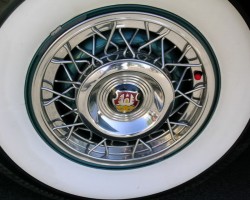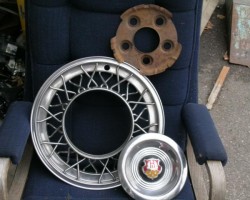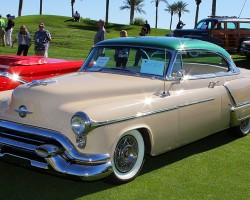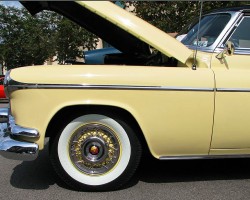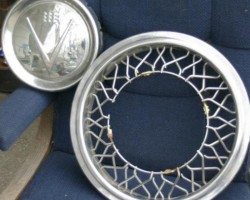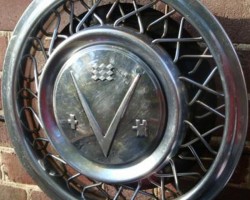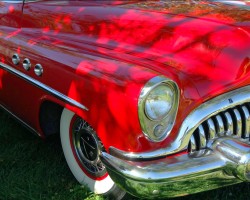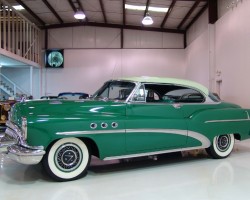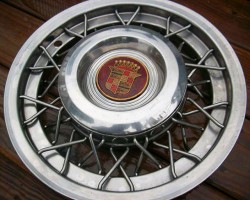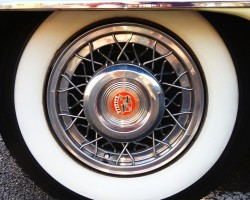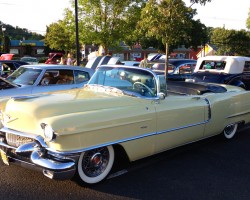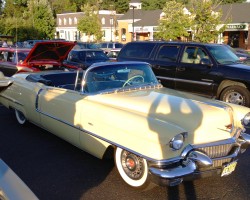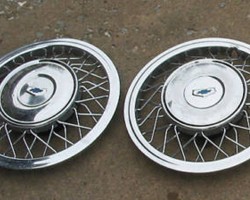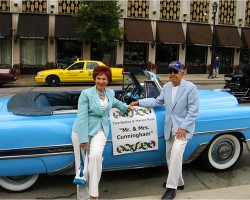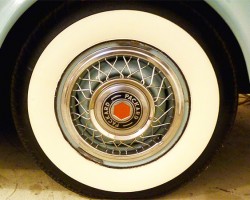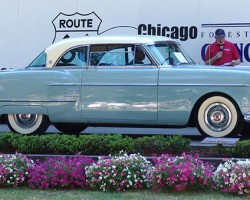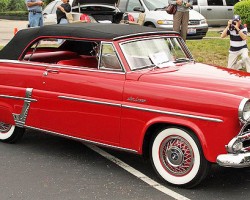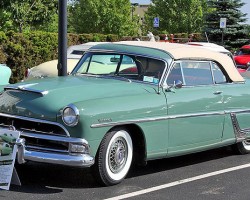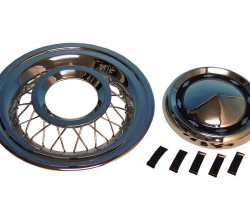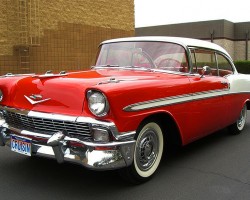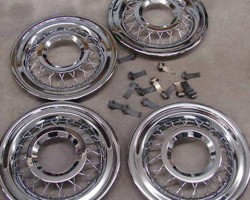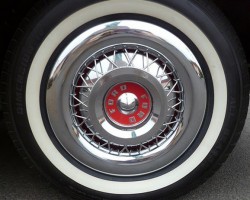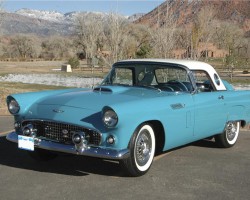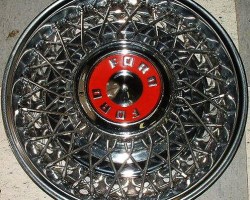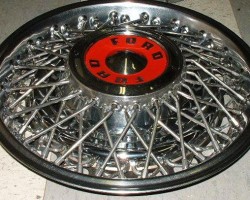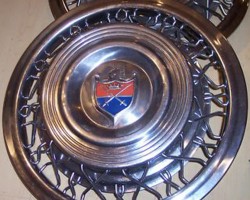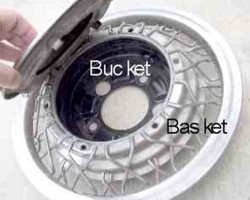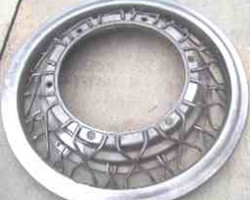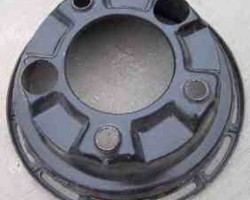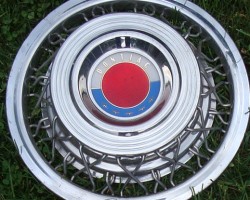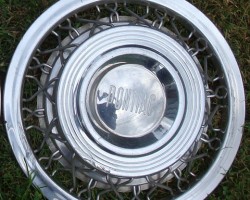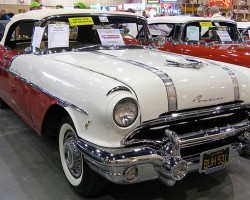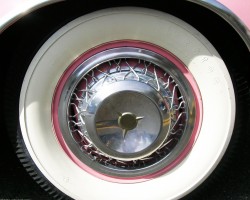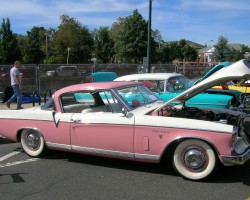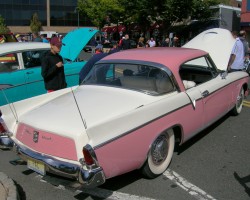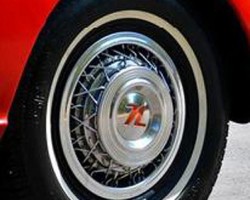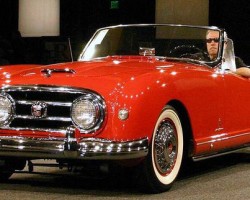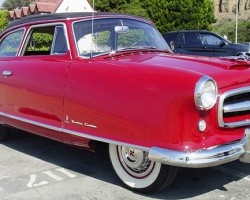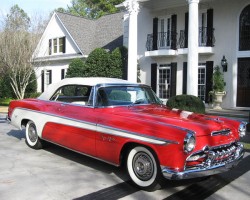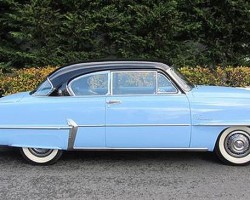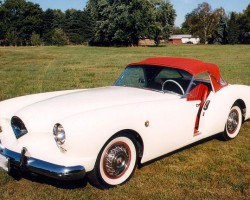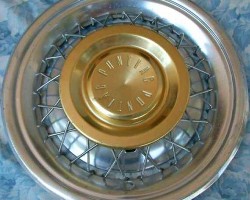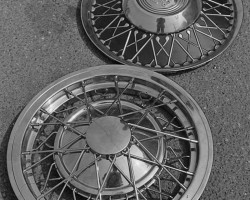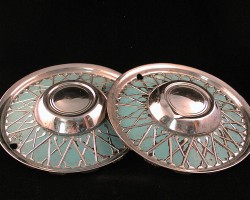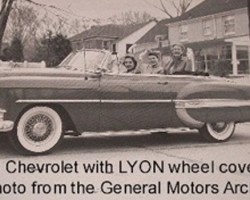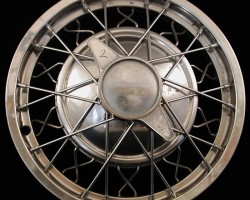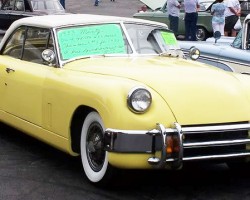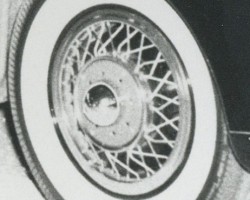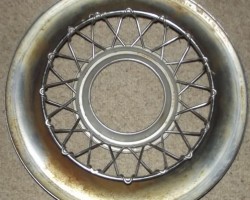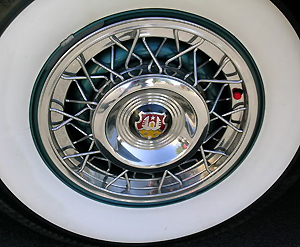
General Motors popularized simulated wire wheel covers that snapped on over steel wheels in 1953 by offering them as a factory option across Oldsmobile, Buick, Cadillac, Pontiac, and Chevrolet divisions… (Shown: 1953 Oldsmobile Ninety-Eight) Credit: The Century Mark
We have always been fans of simulated wire wheel covers at Classic Cars Today Online. While they are an automotive accessory extremely subject to personal taste, one cannot deny wire wheel covers are uniquely American in flavor. Mostly shunned by Europeans and Asian brands, they have populated the automotive landscape in the United States for decades since the early 1950s. Love them or hate them, it’s hard to deny they have earned their spot in classic car nostalgia.
While many disagree on who created the first simulated wire wheel cover, aftermarket auto parts makers began selling them in large numbers during 1951. The visual flair appealed immediately to car buyers benefiting (many for the first time in their lives) from a prosperous post-war economy – Buyers who were eager to forget industrial low-budget plain steel wheels that signified the harder times of the Great Depression. Because wire wheel covers were a new and unknown item in the marketplace, passerbys often mistook them for the genuine article. Because the covers added a great deal of “bling” at a fraction of the cost of real wire wheels, they caught on quickly in the early 1950s – and were often combined with white wall tires for effect.
Seeing the popularity of simulated wire wheel covers grow, automakers began scrambling to cash in. Almost immediately, all five General Motors divisions (Chevrolet, Pontiac, Oldsmobile, Buick, Cadillac), three Chrysler Corporation divisions (Dodge, Plymouth, DeSoto), as well as Nash, Kaiser and Studebaker worked with existing aftermarket producers to produce factory-branded versions for their factory option sheets for 1953.
Crisscrossing spokes were the design of every 1950s wire wheel cover, simulating how authentic wire wheels were built on virtually all vehicles from the turn of the century through the 1930s. It would not be until the 1960s that wire wheel covers went to straight, non-crisscrossing spokes (to be featured in upcoming Part II 1960s article).
CLICK ON ANY OF THE PICTURES IN THE SLIDE SHOW BELOW TO EXPAND TO FULL SIZE. USE ARROWS UNDERNEATH THE PICTURE TO SCROLL BACKWARD OR FORWARD.
- General Motors popularized simulated wire wheel covers that snapped on over steel wheels in 1953 by offering them as a factory option across Oldsmobile, Buick, Cadillac, Pontiac, and Chevrolet divisions. Shown is a 1953 Oldsmobile Ninety-Eight wire wheel cover.
- Many wire wheel cover designs in the 1950s such as this Oldsmobile (shown in the previous two pictures) came in three parts. A small center cap snapped onto an outer trim ring (basket), with a steel mount piece (bucket) underneath to anchor parts together.
- A 1953 Oldsmobile Ninety-Eight equipped with factory option wire wheel covers
- Another view of a 1953 Olds with the factory wire wheel covers. Like most American cars from this time, the steel wheels beneath were painted to match the vehicle.
- Like the Oldsmobile and Cadillac wire wheel covers, the Buick offering came in multiple segments.
- The 1953 Buick wire wheel cover assembled.
- 1953 Buick Super 8 with factory original wire wheel covers
- A 1953 Buick Super fitted with the optional wire wheel covers
- Many Cadillacs were equipped with real wire wheels in the 1950s, but for the more budget-conscious Cadillac borrowed the Oldsmobile wire wheel cover (previous three pictures) and fitted its own center cap.
- Here, an original-specification wire wheel cover is seen on a 1956 Cadillac.
- 1956 CADILLAC COUPE DEVILLE convertible
- 1956 CADILLAC COUPE DEVILLE convertible
- Rather than develop its own wire wheel cover design, the Chevrolet division contracted an aftermarket company to produce this design with the bowtie logo from 1953-55.
- Wisconsin resident John Romppainen’s 1953 Chevrolet Bel Air was picked to chauffer Marion Ross and the late Tom Bosley (aka Marion and Howard Cunningham) from the long-running ’50s-era sitcom “Happy Days” — for a day of festivities and the unvieling of a bronze statue of The Fonz in Milwaukee.
- During the early 1950s, Packard contracted the same aftermarket supplier as Chevrolet (see prior two pictures) – both used the identical wheel cover design.
- A better view of a 1953 Packard Pacific equipped with wire wheel covers shown in the previous picture.
- Hudson also put its logo on these same wire wheel covers during the early to mid-1950s (shown: 1954 Hudson Jet convertible)
- A 1954 Hudson Hornet equipped with the same re-licensed wire wheel covers.
- During the 1950s, many auto parts producers peddled wire wheel add-ons, which fit over basic dog dish- center caps to create a one-piece look. Shown to the right of this photo is a 1955-56 Chevrolet wheel center cap.
- 1956 Chevrolet Bel Air hardtop coupe with ’50s style aftermarket wire wheel covers
- Aftermarket wheel covers were also made to fit over Ford center caps and even full wheel covers…
- Shown here is the wire wheel add-on from the previous photo fitted over a Ford wheel center cap.
- A 1956 Ford Thunderbird equipped with the same wire wheel add-ons. Here, they are fitted over full original Thunderbird wheel covers here.
- Ford offered these full wire wheel covers during the mid-1950s. Unlike the previous pictures shown, these Ford were one-piece units.
- A closer angled view of the authentic 1950s Ford one-piece wire wheel covers.
- During the 1950s, aftermarket parts producer Lyon sold a large number of wire wheel covers of this design. Many automakers contracted with Lyon to produce these wire wheels with differing centers featuring each of their logos…
- Many wire wheel cover designs in the 1950s such as the previously shown Lyon model came in three parts. A small center cap snapped onto an outer trim ring (basket), with a steel mount piece (bucket) underneath for mounting onto the car wheel.
- A better view of the Lyon trim ring (basket) piece by itself.
- A close up view of the back side of the Lyons bucket piece.
- For 1954, Pontiac used the same Lyon design but revised the center cap.
- The 1955-56 version of the Pontiac-Lyon wire wheel cover.
- A 1956 Pontiac Star Chief equipped with the optional wire wheel covers shown in the previous picture.
- Original equipment re-badged Lyon wire wheel covers were also used by Studebaker beginning in 1955.
- A 1956 Studebaker Golden Hawk with original equipment Lyons wire wheel covers.
- 1956 STUDEBAKER GOLDEN HAWK with original factory wire wheel covers.
- Nash also rebranded the Lyon wheel covers during the 1950s with their trademark N logo.
- A 1955 Nash-Healey LeMans convertible equipped with original wire wheel covers as shown in the previous photo.
- A 1953 Nash Metropolitan also equipped with original Nash/Lyon wire wheel covers. A side note: 1953 was the last year before Nash and Hudson merged to form American Motors.
- This 1955 DeSoto Firefly shows the DeSoto branded version of the Lyon wire wheel cover.
- A 1954 Plymouth Belvedere equipped with yet another rebadged version of the Lyon wire wheel covers. Plymouth used a low-relief painted sailing ship logo on their centers while Dodge used a ship logo of a different design.
- Kaiser also sold rebadged Lyon wire wheel covers as their own during the 1950s, as shown on this 1954 Darrin model.
- Pontiac offered this wire wheel cover with gold center caps during 1957-1958 and beyond. As typical of virtually every 1950s wire wheel cover design, spokes were cross-laced to replicate the earliest wire wheels from the turn of the century.
- Lyon also produced this popular selling pseudo wire wheel cover during the 1950s. The background surrounding the raised simulated spokes was painted – most often black, but sometimes other colors…
- Another view of the Lyon pseudo wire wheel covers. Unlike the previous photo, the metal below the raised spokes on these wheel covers was painted to match the body color of the car.
- Full view of a 1953 Chevrolet Bel Air equipped with Lyon wire wheel covers seen in the prior picture.
- This wire wheel cover produced by aftermarket parts maker Calnevar was another popular seller during the 1950s.
- A 1953 Muntz Jet equipped with Calnevar brand aftermarket wire wheel covers (as shown in previous photo).
- Another style of wire wheel covers that sold well during the 1950s was this style, by Panther.
- An unknown brand of 1950s wire wheel cover surrounding trim.

